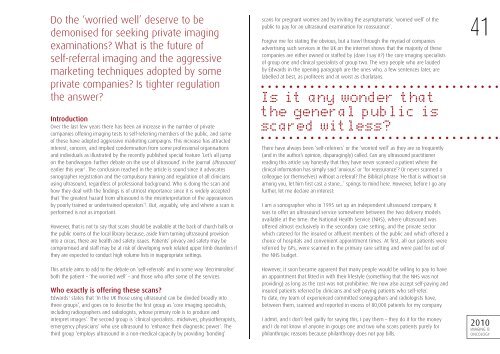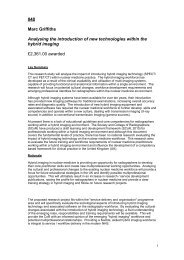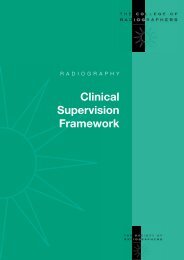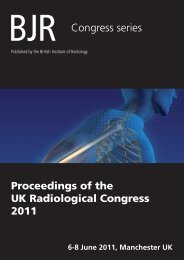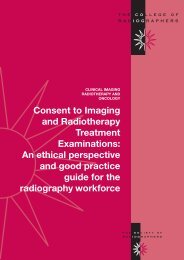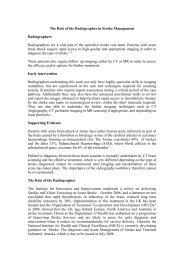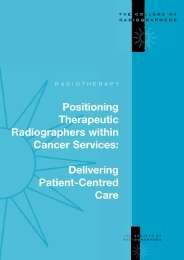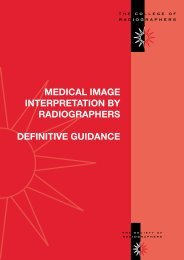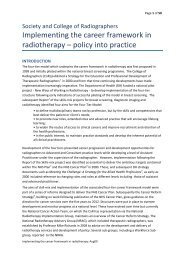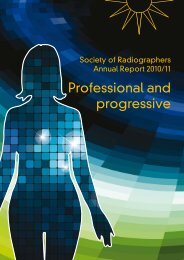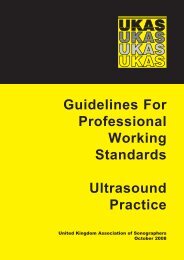IMAGING & ONCOLOGY - Society of Radiographers
IMAGING & ONCOLOGY - Society of Radiographers
IMAGING & ONCOLOGY - Society of Radiographers
- No tags were found...
Create successful ePaper yourself
Turn your PDF publications into a flip-book with our unique Google optimized e-Paper software.
Do the ‘worried well’ deserve to bedemonised for seeking private imagingexaminations? What is the future <strong>of</strong>self-referral imaging and the aggressivemarketing techniques adopted by someprivate companies? Is tighter regulationthe answer?IntroductionOver the last few years there has been an increase in the number <strong>of</strong> privatecompanies <strong>of</strong>fering imaging tests to self-referring members <strong>of</strong> the public, and some<strong>of</strong> these have adopted aggressive marketing campaigns. This increase has attractedinterest, concern, and implied condemnation from some pr<strong>of</strong>essional organisationsand individuals as illustrated by the recently published special feature ‘Let’s all jumpon the bandwagon: further debate on the use <strong>of</strong> ultrasound’ in the journal Ultrasoundearlier this year 1 . The conclusion reached in the article is sound since it advocatessonographer registration and the compulsory training and regulation <strong>of</strong> all cliniciansusing ultrasound, regardless <strong>of</strong> pr<strong>of</strong>essional background. Who is doing the scan andhow they deal with the fi ndings is <strong>of</strong> utmost importance since it is widely acceptedthat ‘the greatest hazard from ultrasound is the misinterpretation <strong>of</strong> the appearancesby poorly trained or undertrained operators’ 2 . But, arguably, why and where a scan isperformed is not as important.However, that is not to say that scans should be available at the back <strong>of</strong> church halls orthe public rooms <strong>of</strong> the local library because, aside from turning ultrasound provisioninto a circus, there are health and safety issues. Patients’ privacy and safety may becompromised and staff may be at risk <strong>of</strong> developing work related upper limb disorders ifthey are expected to conduct high volume lists in inappropriate settings.scans for pregnant women and by inviting the asymptomatic ‘worried well’ <strong>of</strong> thepublic to pay for an ultrasound examination for reassurance’.Forgive me for stating the obvious, but a trawl through the myriad <strong>of</strong> companiesadvertising such services in the UK on the internet shows that the majority <strong>of</strong> thesecompanies are either owned or staffed by (dare I say it?) the core imaging specialists<strong>of</strong> group one and clinical specialists <strong>of</strong> group two. The very people who are laudedby Edwards in the opening paragraph are the ones who, a few sentences later, arelabelled at best, as pr<strong>of</strong>i teers and at worst as charlatans.Is it any wonder thatthe general public isscared witless?There have always been ‘self-referrers’ or the ‘worried well’ as they are so frequently(and in the author’s opinion, disparagingly) called. Can any ultrasound practitionerreading this article say honestly that they have never scanned a patient where theclinical information has simply said ‘anxious’ or ‘for reassurance’? Or never scanned acolleague (or themselves) without a referral? The Biblical phrase ‘He that is without sinamong you, let him fi rst cast a stone...’ springs to mind here. However, before I go anyfurther, let me declare an interest:I am a sonographer who in 1995 set up an independent ultrasound company. Itwas to <strong>of</strong>fer an ultrasound service somewhere between the two delivery modelsavailable at the time: the National Health Service (NHS), where ultrasound was<strong>of</strong>fered almost exclusively in the secondary care setting, and the private sectorwhich catered for the insured or affl uent members <strong>of</strong> the public and which <strong>of</strong>fered achoice <strong>of</strong> hospitals and convenient appointment times. At fi rst, all our patients werereferred by GPs, were scanned in the primary care setting and were paid for out <strong>of</strong>the NHS budget.41This article aims to add to the debate on ‘self-referrals’ and in some way ‘decriminalise’both the patient – ‘the worried well’ – and those who <strong>of</strong>fer some <strong>of</strong> the services.Who exactly is <strong>of</strong>fering these scans?Edwards 1 states that ‘In the UK those using ultrasound can be divided broadly intothree groups’, and goes on to describe the fi rst group as ‘core imaging specialists,including radiographers and radiologists, whose primary role is to produce andinterpret images’. The second group is ‘clinical specialists...midwives, physiotherapists,emergency physicians’ who use ultrasound to ‘enhance their diagnostic power’. Thethird group ‘employs ultrasound in a non-medical capacity by providing ‘bonding’However, it soon became apparent that many people would be willing to pay to havean appointment that fi tted in with their lifestyle (something that the NHS was notproviding) as long as the cost was not prohibitive. We now also accept self-paying andinsured patients referred by clinicians and self-paying patients who self-refer.To date, my team <strong>of</strong> experienced committed sonographers and radiologists have,between them, scanned and reported in excess <strong>of</strong> 80,000 patients for my company.I admit, and I don’t feel guilty for saying this, I pay them – they do it for the moneyand I do not know <strong>of</strong> anyone in groups one and two who scans patients purely forphilanthropic reasons because philanthropy does not pay bills.2010<strong>IMAGING</strong> &<strong>ONCOLOGY</strong>


